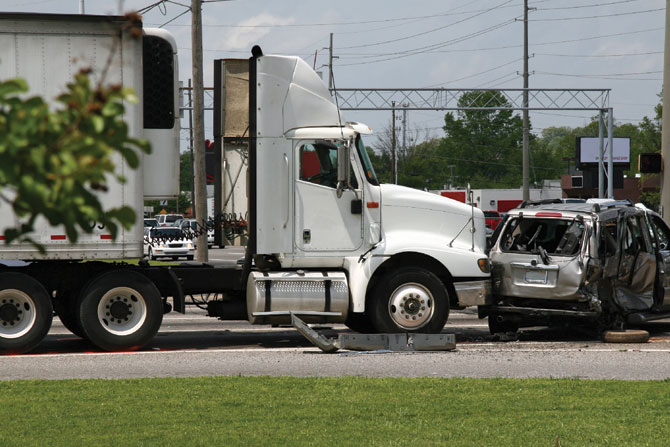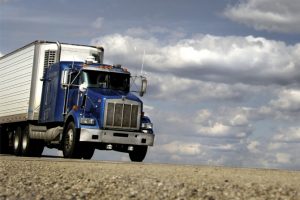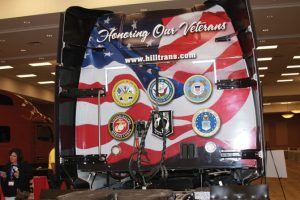Fraudulently staged “accidents” targeting truckers are increasing, but motor carriers can fight back with video evidence by educating their drivers and being prepared before the encounter happens.
That advice came from Matthew Smith, executive director of the Coalition Against Insurance Fraud and an attorney who, for 35 years, defended insurance companies in court.
Smith said staged accidents were common for many years, but then happened less often at the turn of the millennium when crooks shifted their focus to internet-based fraud. They returned with the advent of the Great Recession around 2008 and 2009 and have increased since then.
In Louisiana, an organized crime ring led by an attorney staged a series of accidents that so far has led to 33 indictments and 23 guilty pleas, as reported by Transport Topics. The attorney in June pleaded guilty to conspiracy to commit mail and wire fraud, and faces up to five years in prison. In June, a married couple who was part of the ring was sentenced to 48 months in federal prison for participating in a staged accident that resulted in $4.7 million in court settlements with C.R. England. That carrier and also Southeastern Motor Freight have filed racketeering lawsuits against the perpetrators.
Dangerous Plots From Criminal Minds
Fraudsters are targeting commercial vehicles for several reasons, Smith said. First, while a passenger car may or may not carry adequate insurance, a commercial vehicle is assured of having a large-dollar insurance policy. Also, a big rig is harder to brake [to a stop], and the “accident” is more likely to create a more dramatic impact and graphic photos, Smith said.
Smith’s Coalition Against Insurance Fraud was created in 1993 by two groups that often work against each other – what is now the American Property and Casualty Insurance Association, which represents insurance companies, and the Consumer Federation of America, a consumer advocate organization. The groups came together to target insurance fraud, which Smith called “the crime we all pay for.”
“One of the things that seems to be also true across all aspects of insurance fraud: The fraudsters are smarter than people often give them credit for.”
– Matthew Smith, Executive Director, Coalition Against Insurance Fraud
Smith said many staged accidents occur on larger roadways and interstate highways. Crooks will stake out areas where they are sure there are no cameras. Sometimes they will stage accidents shortly after a rainstorm because the wet roads make it harder for the big rig to stop. Sometimes they will commit the crime in the early morning hours because fewer witnesses will be present.
“One of the things that seems to be also true across all aspects of insurance fraud: The fraudsters are smarter than people often give them credit for,” he said.
Fraudsters use a variety of methods to try to bait truck and passenger drivers into an accident. One is the “swoop and squat,” where one motorist will settle in front of the truck and then another motorist will cut in front of that vehicle. Then the middle vehicle will hit the brakes, causing an accident blamed on the truck. Rear-end collisions pay out more therapy and medical claims because of neck and back injuries. Other tricks include a simple sideswipe where a passenger vehicle enters the truck’s lane, hits the truck and then the fraudster claims the truck came into their lane. In the “wave-in” method, a motorist at an intersection will signal to another driver that the coast is clear, but it’s a setup for another car to be hit. Once the “accident” occurs, the wave-in driver disappears. Fraudsters using the T-bone method wait at an intersection, strike another vehicle and have a witness planted who claims the victim ran a stop sign.
What kind of driver would purposely let himself be hit by a big rig? Someone who wants money. Smith said perpetrators have an advantage over regular accident victims because they are prepared and even trained.
“If you’re in a staged accident and you’re in the middle vehicle that’s in the swoop and squat, you know exactly what’s going to happen, and you know the speed that you want to be at,” Smith said. “Some of these are even trained people who’ve done this multiple times under multiple identities. So they know the correct speed to go, they know when to brake, they know how to brace themselves for the impact itself, and they know exactly what is going to happen.”
Capturing Evidence
How can trucking companies defend themselves? The first, most basic tool is to equip their cabs with video. As Smith explained, “If we say a picture is worth a thousand words, literally the video to be able to show to law enforcement, to be able to show in a court of law is worth 10,000 to 100,000 words.”
Jim Angel, vice president of video telematics for EROAD, said customers have told him that after a staged collision, they could see the incident on their web portal, contact the driver and send the video to his cell phone to show the officer.
“The quicker you can get that information to enforcement, the larger opportunity there is to reverse the narrative around whether or not your driver receives the citation. … If the driver does receive a citation, then that starts the blame of whose fault the accident was,” he said. “So it’s very important to try to get that information out there sooner than later to be able to direct that narrative.”
In one case, video showed the truck stopped at a red light along with a sport utility vehicle carrying five adults. When the light changed to green, the car and truck accelerated. Another SUV appeared on the right-hand side and accelerated to take position as part of a swoop-and-squat operation.
But the scammers’ timing was off. The truck driver’s video showed the middle SUV hit its brakes a full second to a second-and-a-half before the associate SUV swerved in front. There was no reason to do so and cause the minor collision with the truck behind it. The video also showed the crooks climb out of the SUV and wander around looking uninjured. Two walked back to the truck driver and talked to him.
Captain Peter Bergstresser of the Florida Highway Patrol likewise encouraged motor carriers to equip their trucks with cameras.
“It’s up to the trooper to really look at things, but it’s also up to the truckers to really safeguard themselves, have those cameras on the trucks, have cameras everywhere,” he said. “Somebody waves you out, maybe think about that for a second – like, hmm. Is this a trap? Is somebody going to try to sue me or run into me?”
Sometimes there can be an interaction with a passenger that can provide information advantageous to the truck driver.
When it comes to using video properly, Angel recommends carriers create a policy and then stick to it. Following a policy inconsistently can get a company in real trouble.
Drivers should be taught that they can gather information at the scene – skid marks, broken tail lights, positions of vehicles, etc. They can take their own photographs.
In addition to equipping their trucks with cameras, Smith said motor carriers should inform their drivers about these schemes and scams so they can use the right words when talking to the officer. Drivers should be taught that they can gather information at the scene – skid marks, broken tail lights, positions of vehicles, etc. They can take their own photographs.
“They need to have an active plan in place,” he said. “They need to inform their drivers, whether they have two drivers or two thousand drivers, here’s our anti-fraud plan. If you suspect that you’ve been in an accident that may involve insurance fraud, here’s who you notify, here’s how you do it and here’s how you document it. And have those written plans, policies and procedures in place.”
A Good Defense
Finally, motor carriers should partner with their insurance providers. They have a right to demand information about the provider’s anti-fraud program before purchasing coverage.
Smith’s group does more than just instruct carriers how to protect themselves against staged accidents. It also advocates for regulatory and legislative changes. One New York law named for grandmother Alice Ross, who died in a staged accident, made it a crime to cause one. Smith’s group and other industry advocates are seeking to pass the law on a national level and in other states with increased penalties if the victim is injured or killed.
The fear of staged accidents goes hand in hand with the fear of a large settlement. In the American Transportation Research Institute’s annual “Critical Issues in the Trucking Industry” survey, insurance cost/availability and tort reform both returned to the top 10 after many years outside it. In another study, ATRI reported that nuclear verdicts are on the rise.

One factor that is leading to more of those huge verdicts is the plaintiff’s attorneys’ skillful use of the “reptile theory,” which activates jury members’ primal fears to inspire them to protect themselves, their families and the rest of society against the big, bad trucking companies.
But Smith said the same theory can be used by trucking’s defenders when it comes to staged accidents. A jury member also doesn’t want to become an innocent victim of insurance fraud.
“What became very clear to me, and my entire 35 years were spent as an insurance defense lawyer was, first, this works, and second, this is a great way for me to win cases for my clients,” he said.
Smith said fraudsters will say, after being caught, that they know which insurance companies investigate fraud and how thoroughly they do so. They also know which trucking companies don’t investigate potential fraud committed against themselves. Those that don’t are more exposed.
“They will test,” he said. “So they’ll do a staged accident, and if it’s not investigated and there’s a very quick settlement for what they consider to be a very large amount of money, you just put a target on the back of your truck because they’re going to get you again.”
Angel said carriers must stand up for themselves and their industry.
The consequences of not responding to suspicious accidents are huge. “It’ll just continue to happen,” Smith said.
Originally published in the Arkansas Trucking Report Vol. 26 Issue 4.










